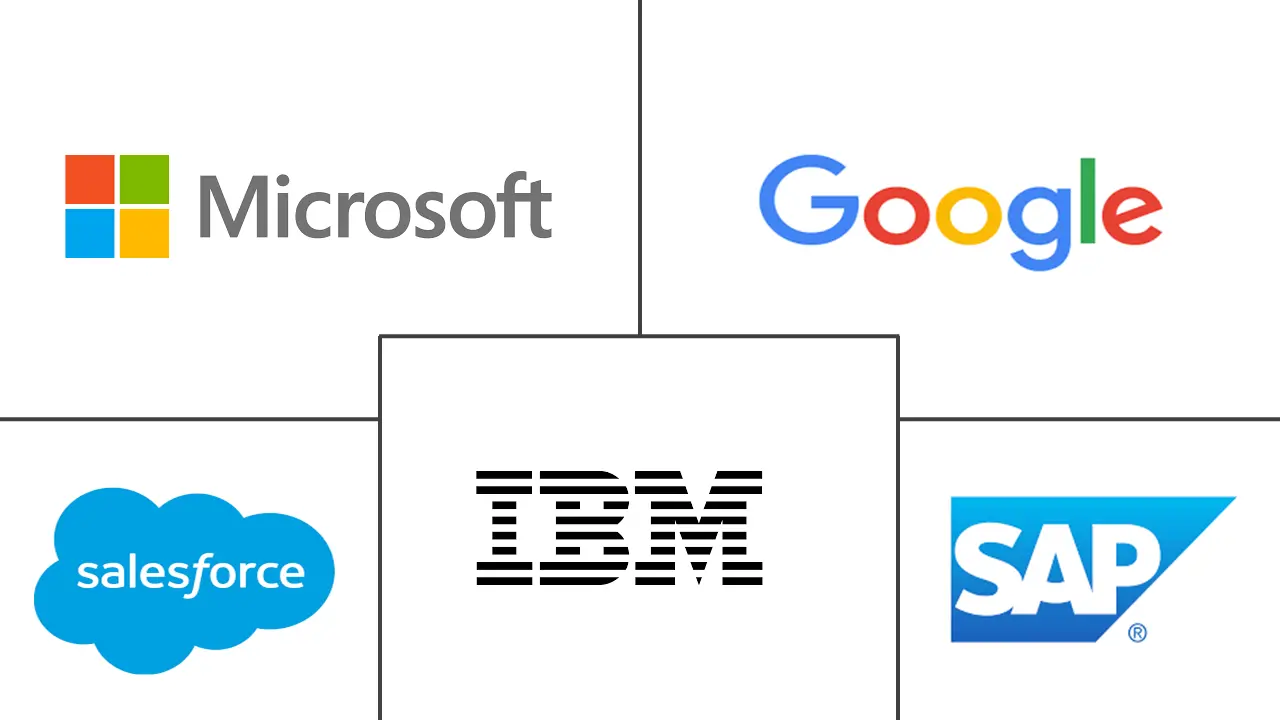Artificial Intelligence In Retail Market Size and Share

Artificial Intelligence In Retail Market Analysis by Mordor Intelligence
The Artificial Intelligence In Retail Industry is expected to grow from USD 14.24 billion in 2025 to USD 96.13 billion by 2030, at a CAGR of 46.54% during the forecast period (2025-2030).
This steep trajectory is propelled by retailers that embed advanced analytics and generative models into pricing, merchandising, and customer-engagement workflows. Demand forecasting engines that lift accuracy by 15% and cut overstocks by 10% are delivering immediate working-capital improvements, while edge-based computer-vision systems accelerate autonomous checkout adoption and drive basket-value gains of up to 35%. Cloud cost curves continue to fall, expanding access to enterprise-grade AI stacks for mid-tier retailers. At the same time, regional regulation around data privacy and algorithmic fairness is prompting investment in local inference and privacy-preserving architectures. Competitive intensity is rising as hyperscalers package retail-specific AI toolkits and seal multi-year deals with global chains.
Key Report Takeaways
- By channel, omnichannel strategies commanded 45.7% of Artificial Intelligence in Retail market share in 2024, while pure-play online retailers are projected to expand at a 19.8% CAGR to 2030.
- By component, software solutions held 61.3% share of the AI in retail market size in 2024; managed services are forecast to grow at 21.3% CAGR through 2030.
- By deployment, cloud platforms accounted for 71.8% share of the artificial intelligence in retail market size in 2024, whereas edge-hybrid architectures are advancing at a 24.7% CAGR to 2030.
- By application, inventory and demand-forecasting captured 28.3% of AI in retail market share in 2024, and fraud and loss-prevention systems are set to expand at 22.4% CAGR by 2030.
- By technology, machine learning led with 40.21% revenue share in 2024 while generative AI is projected to grow at a 27.6% CAGR to 2030.
- By geography, North America retained 37.4% of artificial intelligence in retail market size in 2024, whereas Asia-Pacific is registering the fastest expansion at an 18.9% CAGR through 2030.
Global Artificial Intelligence In Retail Market Trends and Insights
Drivers Impact Analysis
| Driver | (~) % Impact on CAGR Forecast | Geographic Relevance | Impact Timeline |
|---|---|---|---|
| Rapid adoption of omnichannel AI for personalization | +8.2% | Global, with North America and Europe leading | Medium term (2-4 years) |
| Declining cost and accessibility of cloud-based AI stacks | +7.5% | Global, with emerging markets benefiting most | Short term (≤ 2 years) |
| E-commerce expansion demanding real-time analytics | +6.8% | Asia-Pacific core, spill-over to global markets | Medium term (2-4 years) |
| Generative-AI-powered vision checkout | +5.9% | North America and EU, expanding to Asia-Pacific | Long term (≥ 4 years) |
| Retail media networks monetizing first-party data | +4.3% | North America, primarily, expanding globally | Medium term (2-4 years) |
| ESG-driven AI inventory carbon optimization | +3.1% | Europe leading, North America following | Long term (≥ 4 years) |
| Source: Mordor Intelligence | |||
Rapid adoption of omnichannel AI for personalization
Omnichannel AI now maps full customer journeys and adjusts in real time across mobile, web, and store touchpoints. Target’s Store Companion AI, rolled out to nearly 2,000 locations, illustrates how generative models can serve staff questions while tailoring offers to shoppers. FairPrice Group’s Store of Tomorrow, built on Google Cloud, unifies cart data, in-store sensors, and e-commerce profiles to create a single view of each customer[1]Google Cloud, “FairPrice Group Accelerates Digital Innovation,” cloud.google.com. Such deployments bind physical and digital channels, yet a perception gap persists: while 96% of retailers report project success, only 45% of consumers feel understood, revealing execution shortfalls.
Declining cost and accessibility of cloud-based AI stacks
Unit costs for inference are falling as chip efficiency rises and hyperscalers invest heavily. Amazon earmarked USD 100 billion in AI and AWS infrastructure to keep latency low and capacity high. Microsoft’s Cloud for Retail bundles pre-configured AI modules, slashing deployment cycles for mid-market chains. Partnerships such as Currys with Accenture and Microsoft highlight how retailers bypass talent constraints by renting turnkey stacks. The access shift pressures incumbents who still operate legacy data centers.
E-commerce expansion demands real-time analytics
Streaming analytics lets platforms alter prices and promotions within milliseconds. Walmart’s Element ML backbone processes live demand signals across stores and online to orchestrate replenishment. TikTok’s Brazil launch embedded ChatGPT-style recommendations that spark impulse buys through social feeds. Unified pipelines that merge clickstream, inventory, competitor price, and external trend data maximize revenue per visitor, especially during flash sales, showcasing the growing impact of AI in the retail market.
Generative-AI-powered vision checkout
Accuracy for barcode-free recognition has reached 99.9%, moving frictionless checkout from pilots to chain-wide rollouts. Mashgin’s partnership with Verifone integrates vision and payments, removing cashier bottlenecks. Sam’s Club plans to equip 600 clubs after initial success at 10 sites. Kappture’s BRISK system processes images locally to satisfy European privacy law while keeping latency under 100 ms. Capital outlays remain high, but ROI comes from higher throughput and richer shopper-behavior data.
Restraints Impact Analysis
| Restraint | (~) % Impact on CAGR Forecast | Geographic Relevance | Impact Timeline |
|---|---|---|---|
| Data-privacy regulations limiting data harvesting | -4.7% | Europe leading, global expansion | Short term (≤ 2 years) |
| Shortage of retail-specific AI talent | -3.9% | Global, acute in emerging markets | Medium term (2-4 years) |
| Algorithmic bias risk in dynamic pricing | -2.8% | North America and EU regulatory focus | Medium term (2-4 years) |
| Edge-compute energy cost in micro-fulfillment | -2.1% | Urban centers globally | Long term (≥ 4 years) |
| Source: Mordor Intelligence | |||
Data-privacy regulations limiting data harvesting
The EU AI Act elevates retail algorithms to “high-risk,” obliging mandatory transparency, human oversight, and impact assessment. Retailers must now run Data Protection Impact Assessments and embed privacy-by-design from code commit through model retraining. Localized LLMs that never leave company firewalls are emerging as a compliance hedge, yet smaller chains struggle with cost and governance overhead.
Shortage of retail-specific AI talent
Brazil alone reports a 500,000-person shortfall in qualified AI professionals. NVIDIA’s 2024 survey shows 42% of retailers using AI, but half cite lack of skills as a top barrier[2]NVIDIA Corporation, “Retail AI Adoption Survey 2024,” nvidia.com. Large employers turn to AI-based hiring: Walmart filled 400,000 roles in under five months via algorithmic screening. Wage inflation and project delays persist, steering many chains toward managed services.
Segment Analysis
By Channel: Omnichannel integration accelerates retail convergence
Omnichannel approaches held a dominant 45.7% artificial intelligence in retail market share in 2024, emphasizing the strategic value of unified data flows across store, web, and mobile. Pure-play online models, though smaller, are scaling fastest at a 19.8% CAGR as cloud-native architectures let them launch AI pilots without ripping out legacy POS layers. Brick-and-mortar chains are leveraging in-store IoT sensors to feed behavioral data back into recommendation engines, improving cross-sell accuracy and raising conversion.
Investment momentum underscores the shift: leading UK apparel chain Matalan applied generative AI to product descriptions and quadrupled copy throughput, trimming content cost while preserving brand tone. Conversely, specialty chains that silo e-commerce from store teams report inconsistent recommendations and cart-abandon spikes. Looking ahead, mixed-reality fitting rooms and mobile checkout promise to blur any remaining distinction between channels.
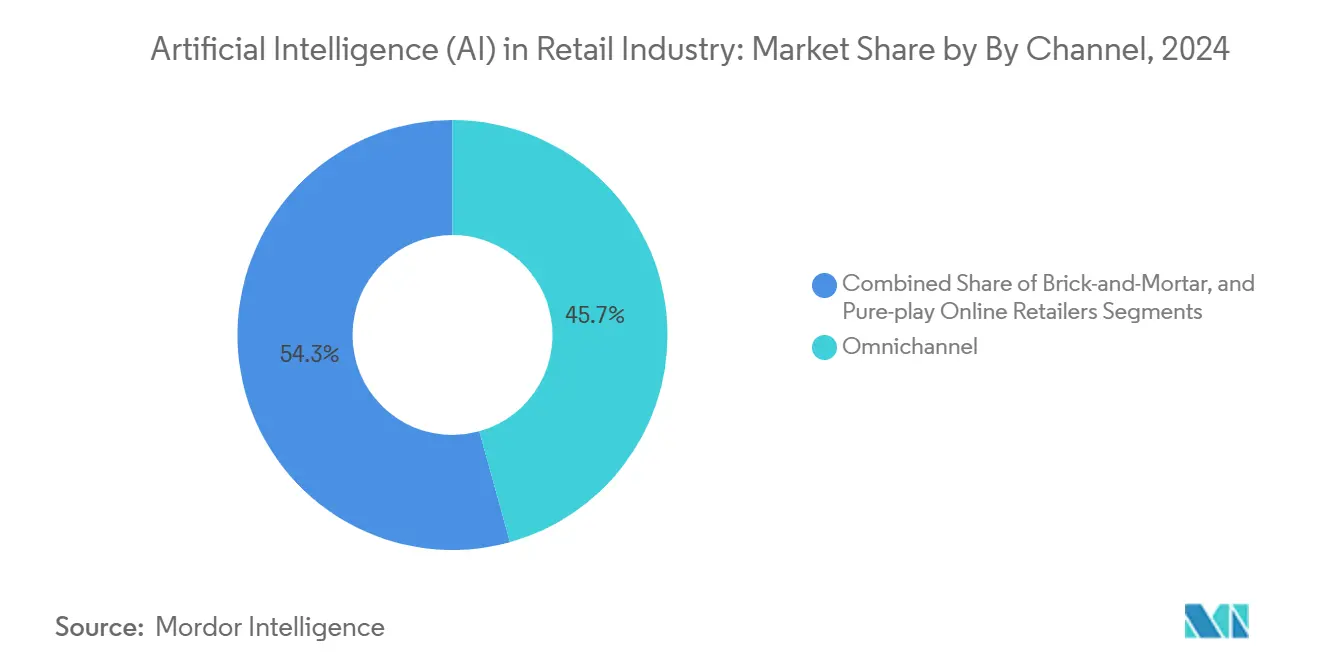
Note: Segment shares of all individual segments available upon report purchase
By Component: Managed services gain traction
Software platforms still contributed 61.3% of artificial intelligence in retail market size during 2024, covering predictive-analytics engines, LLM-powered chatbots, and vision-recognition APIs. Yet managed services are rising at 21.3% CAGR as retailers outsource model tuning, MLOps, and compliance. For cash-constrained banners, opex-style AI is easier to defend than multimillion-dollar licenses.
Service specialists bundle domain know-how, shelf-allocation heuristics, markdown timing, and labor scheduling into pre-trained models. This shrink-wrapped expertise eases adoption for chains lacking data-science benches. Professional services growth is steadier, focused on advisory projects such as AI readiness audits and ethical-risk mapping.
By Deployment: Edge-hybrid solves latency and privacy
Cloud maintained 71.8% of AI in retail market size in 2024 due to elasticity and pay-as-you-go economics. Edge-hybrid schemes, however, are surging at 24.7% CAGR as checkout vision, planogram compliance, and theft detection demand sub-second inference. EdgeRec3D showed that in-store compute paired with cloud training lifted sales by 35% in live A/B tests.
Hybrid models partition workloads: raw images stay on-premises for inference; anonymized embeddings travel to cloud clusters for retraining. Retailers gain privacy compliance and bandwidth savings without forfeiting central model governance. On-premises only survives in high-security niches such as luxury or defense-adjacent commissaries.
By Application: Inventory optimization delivers immediate ROI
Inventory and demand-forecast tools captured 28.3% artificial intelligence in retail market share last year as CFOs prioritize cash-cycle efficiency. Algorithms that absorb weather signals, promotions, and local events routinely reduce safety stock while limiting stockouts. Fraud and loss-prevention, growing 22.4% CAGR, uses behavior analysis and computer vision to flag shrinkage anomalies and ORC rings in real time.
Supply-chain routing, store-level picking, and autonomous warehouses round out high-value operations layers. Payment, pricing, and checkout analytics pair real-time risk scoring with dynamic discounts to maximize conversion. Customer-relationship engines close the loop with churn-propensity and lifetime-value scoring that inform campaign budgets.
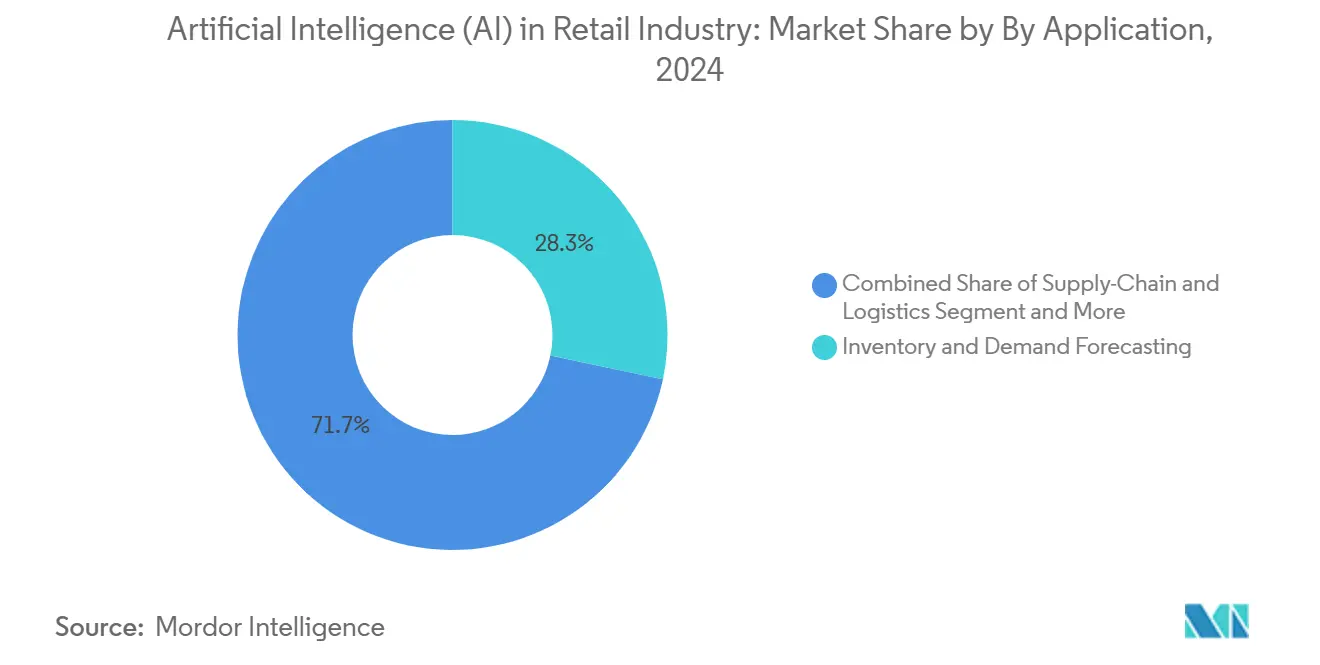
By Technology: Generative AI supplements ML core
Machine-learning frameworks formed 40.21% revenue share in 2024 as the base for forecasting, clustering, and scoring workloads. Generative AI, expanding at a 27.6% CAGR, augments this core with text, image, and code synthesis. Amazon now fields roughly 1,000 generative use cases, including Rufus, a shopping assistant answering 500,000 queries daily.
Natural-language processing underpins contact-center bots, merchandise search, and voice commerce, while computer vision automates shelf audits and self-checkout. Reinforcement strategies iterate price and promotion knobs to balance margin and sell-through dynamically, reflecting the growing influence of artificial intelligence in the retail market.
Geography Analysis
North America controlled 37.4% of artificial intelligence in retail market size in 2024, buoyed by robust cloud infrastructure, venture capital, and retailers willing to pilot bleeding-edge models. Walmart’s 4.8% revenue uplift from generative-AI-driven merchandising underscores tangible returns. Regulatory scrutiny around bias and pricing discrimination is intensifying, yet transparent model governance practices are helping majors keep deployment on track. Investments continue in proprietary stacks such as Walmart Element and Target Store Companion to maintain competitive moats.
Asia-Pacific is the growth engine, expanding at 18.9% CAGR through 2030. Mobile-first consumers, government funding, and aggressive digital-native entrants create fertile ground. In India, 80% of retailers intend to scale AI in 2025, with expectations that generative models will raise frontline productivity by as much as 37%. China’s social-commerce titans combine live video, conversational AI, and integrated payments to optimize impulse purchasing. ASEAN markets leapfrog traditional POS with cloud-only solutions, though uneven broadband and skills gaps temper rollout speed in secondary cities.
Europe balances innovation and regulation. GDPR and the upcoming AI Act demand rigorous privacy-impact audits, pushing chains toward federated learning and edge encryption. Sainsbury’s five-year pact with Microsoft exemplifies partnerships that blend compliance with state-of-the-art tools. Intermarché’s smart-cart pilot and IKI Lithuania’s age-estimation checkout illustrate practical, privacy-aligned use cases. The region’s patient, ethics-first approach is generating templates for responsible AI that could export globally.
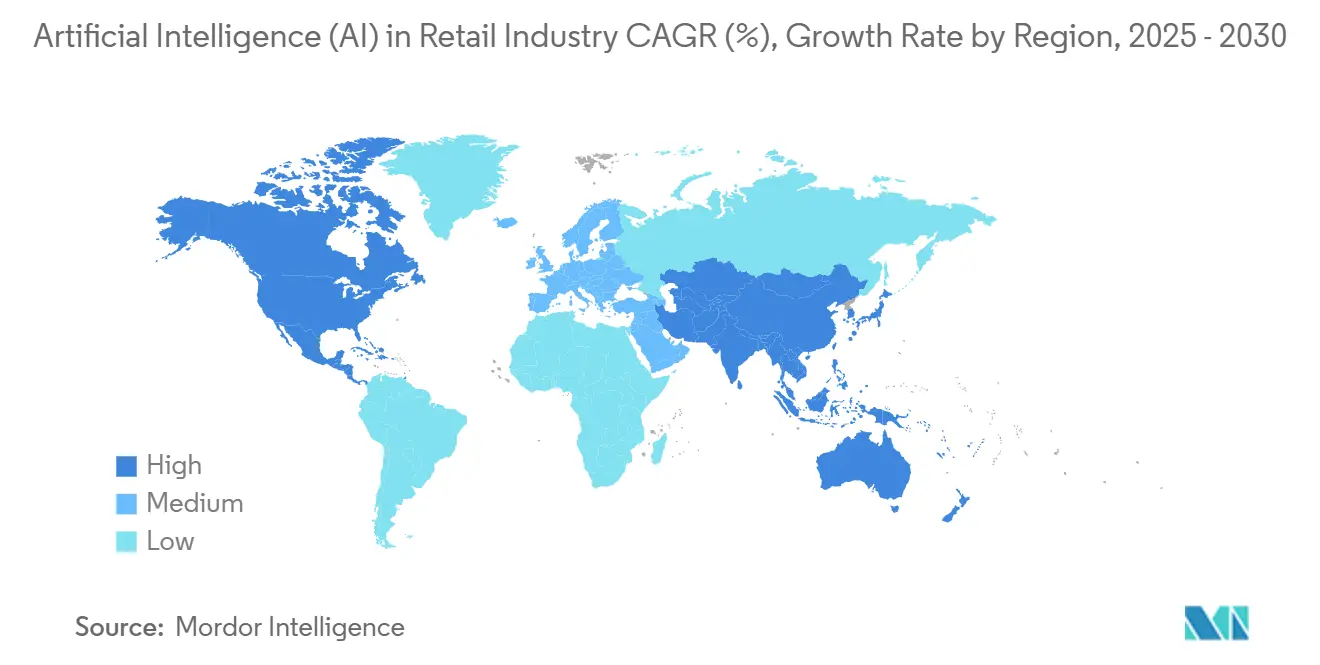
Competitive Landscape
The AI in retail market shows moderate fragmentation. Hyperscalers - Microsoft, Amazon, Google - hold pole positions by embedding retail-specific APIs into their clouds and locking in multi-year alliances. Microsoft’s tie-ups with Sainsbury’s and Victoria’s Secret, Google’s deals with Best Buy and FairPrice, and Amazon’s AWS retail accelerator set platform standards and deter smaller IaaS rivals.
Chip makers such as NVIDIA and Intel court retailers with reference architectures that pair GPUs and optimized SDKs for vision checkout and analytics[3]NVIDIA, “Retail Suite on NVIDIA IGX,” nvidia.com. Systems integrators (Accenture, Cognizant, Infosys) monetize the talent gap through end-to-end project delivery and managed MLOps. Meanwhile, niche vendors - Pixevia in autonomous micro-stores, Daisy Intelligence in demand forecasting - differentiate through domain depth and rapid iteration.
Strategic moves center on ecosystem expansion. Microsoft added a retail media network module to its Cloud for Retail, aiming at first-party data monetization. Amazon opened access to its Just Walk Out stack for third-party stadiums and airports. Google invested in Vertex AI Search for retail, offering grounded generative answers based on private catalog data. Patent filings around AR beauty try-ons and context-aware voice shopping hint at next-generation engagement layers.
Artificial Intelligence In Retail Industry Leaders
-
SAP SE
-
IBM Corporation
-
Microsoft Corporation
-
Google LLC
-
Salesforce Inc.
- *Disclaimer: Major Players sorted in no particular order
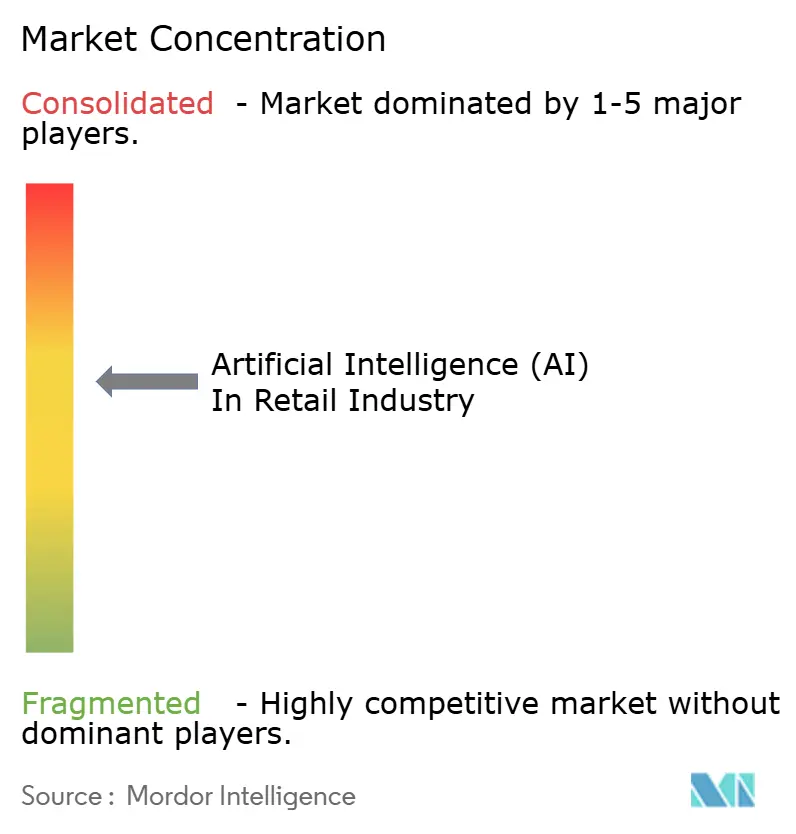
Recent Industry Developments
- June 2025: FairPrice Group unveiled “Store of Tomorrow” with Google Cloud, adding AI carts and video analytics for staff alerts.
- May 2025: Amazon projected USD 100 billion in AI and AWS capex by 2025, supporting roughly 1,000 generative AI use cases.
- April 2025: Kappture launched BRISK checkout-free unit at Norwich City FC, using local vision processing for GDPR compliance.
- February 2025: Indian retailers reported 80% AI expansion plans and AI powering half of new FMCG launches.
Global Artificial Intelligence In Retail Market Report Scope
Artificial intelligence is an approach for teaching a computer, a robot operated by a computer, or software to think critically and creatively like a human mind. AI is achieved by examining the cognitive processes and researching the patterns of the human brain. These research projects produce intelligent systems and software.
The artificial intelligence in the retail market is segmented by channel (omnichannel, brick and mortar, and pure-play online retailers), component (software, service [(managed and professional)]), deployment (cloud and on-premise), application (supply chain and logistics, product optimization, in-store navigation, payment and pricing analytics, inventory management, and customer relationship management((CRM))), technology (machine learning, natural language processing, chatbots, image and video analytics, and swarm intelligence) and geography (North America, Europe, Asia-Pacific, and the Rest of World). The report offers the market size in value terms in USD for all the abovementioned segments.
| Omnichannel |
| Brick-and-Mortar |
| Pure-play Online Retailers |
| Software |
| Services |
| Cloud |
| On-premise |
| Supply-Chain and Logistics |
| Product Optimization and Merchandising |
| In-Store Navigation and Experience |
| Payment, Pricing and Checkout Analytics |
| Inventory and Demand Forecasting |
| Customer Relationship Management |
| Fraud and Loss Prevention |
| Machine Learning and Predictive Analytics |
| Natural Language Processing |
| Generative AI and Large Language Models |
| Computer Vision (Image and Video) |
| Chatbots and Virtual Assistants |
| Swarm and Reinforcement Intelligence |
| North America | United States | |
| Canada | ||
| Mexico | ||
| South America | Brazil | |
| Argentina | ||
| Rest of South America | ||
| Europe | United Kingdom | |
| Germany | ||
| France | ||
| Italy | ||
| Spain | ||
| Nordics | ||
| Rest of Europe | ||
| Middle East and Africa | Middle East | Saudi Arabia |
| United Arab Emirates | ||
| Turkey | ||
| Rest of Middle East | ||
| Africa | South Africa | |
| Egypt | ||
| Nigeria | ||
| Rest of Africa | ||
| Asia-Pacific | China | |
| India | ||
| Japan | ||
| South Korea | ||
| ASEAN | ||
| Australia | ||
| New Zealand | ||
| Rest of Asia-Pacific | ||
| By Channel | Omnichannel | ||
| Brick-and-Mortar | |||
| Pure-play Online Retailers | |||
| By Component | Software | ||
| Services | |||
| By Deployment | Cloud | ||
| On-premise | |||
| By Application | Supply-Chain and Logistics | ||
| Product Optimization and Merchandising | |||
| In-Store Navigation and Experience | |||
| Payment, Pricing and Checkout Analytics | |||
| Inventory and Demand Forecasting | |||
| Customer Relationship Management | |||
| Fraud and Loss Prevention | |||
| By Technology | Machine Learning and Predictive Analytics | ||
| Natural Language Processing | |||
| Generative AI and Large Language Models | |||
| Computer Vision (Image and Video) | |||
| Chatbots and Virtual Assistants | |||
| Swarm and Reinforcement Intelligence | |||
| By Geography | North America | United States | |
| Canada | |||
| Mexico | |||
| South America | Brazil | ||
| Argentina | |||
| Rest of South America | |||
| Europe | United Kingdom | ||
| Germany | |||
| France | |||
| Italy | |||
| Spain | |||
| Nordics | |||
| Rest of Europe | |||
| Middle East and Africa | Middle East | Saudi Arabia | |
| United Arab Emirates | |||
| Turkey | |||
| Rest of Middle East | |||
| Africa | South Africa | ||
| Egypt | |||
| Nigeria | |||
| Rest of Africa | |||
| Asia-Pacific | China | ||
| India | |||
| Japan | |||
| South Korea | |||
| ASEAN | |||
| Australia | |||
| New Zealand | |||
| Rest of Asia-Pacific | |||
Key Questions Answered in the Report
What is the current size of the Artificial Intelligence in Retail market?
The market is valued at USD 14.24 billion in 2025 and is projected to reach USD 96.13 billion by 2030, reflecting a CAGR of 46.54%.
Which application area leads adoption today?
Inventory and demand-forecasting accounts for 28.3% of Artificial Intelligence in Retail market share in 2024, driven by measurable improvements in stock accuracy and working-capital efficiency.
Why are edge-hybrid deployments growing so quickly?
Retailers need sub-second latency for computer-vision checkout and shelf-monitoring while staying compliant with data-privacy laws, making edge-hybrid architectures the fastest-growing deployment model at 24.7% CAGR.
Which region is expanding the fastest?
Asia-Pacific is advancing at an 18.9% CAGR through 2030, supported by mobile-first consumers, government AI programs, and rising investments from local and global retailers.
Page last updated on:
